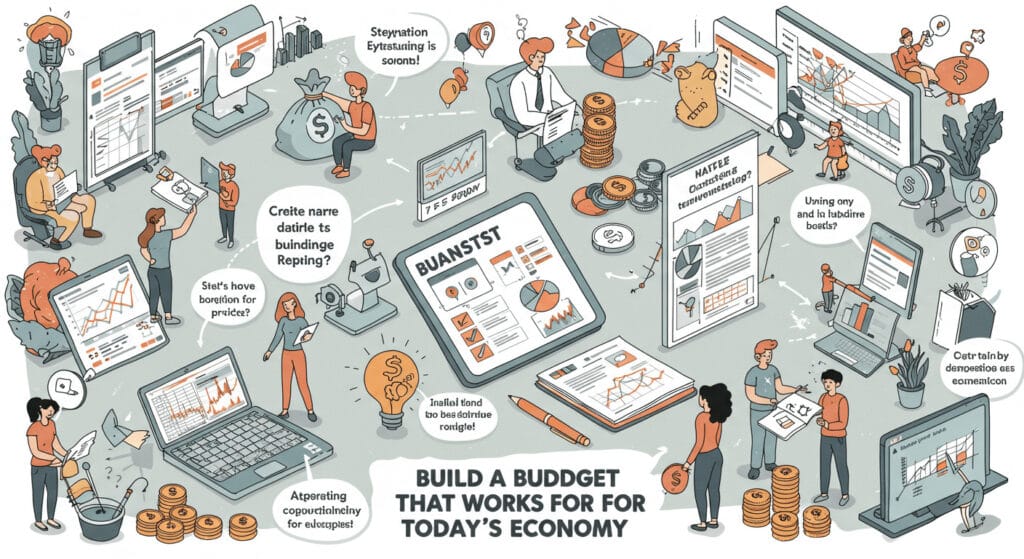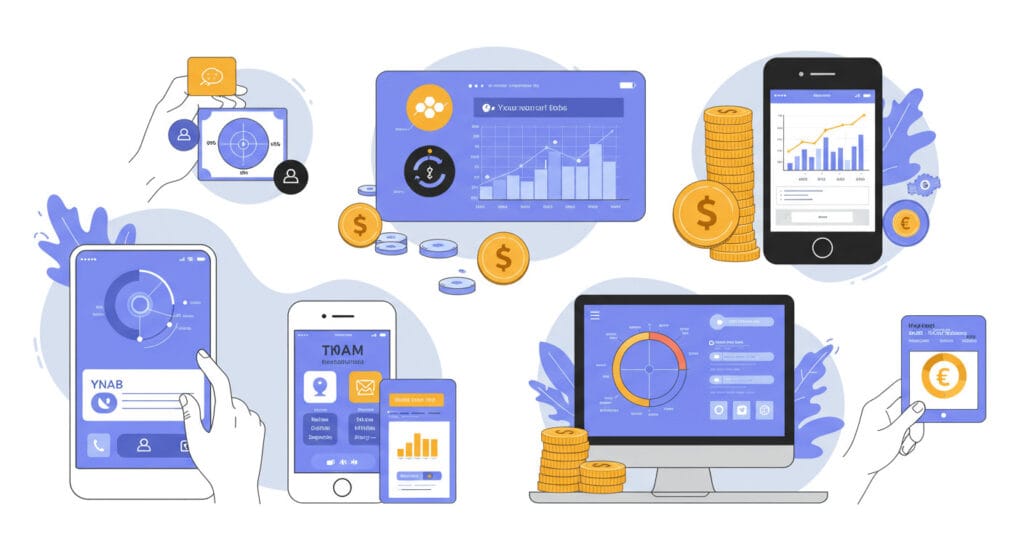Let’s face it: traditional budgeting advice often feels out of touch. You’ve probably heard the same old tips—“cut back on coffee” or “use cash envelopes”—but in today’s fast-paced economy, where prices shift overnight, side hustles are the norm, and AI tools can predict your spending habits, sticking to a rigid 20th-century budget just doesn’t cut it.
The truth is, budgeting isn’t about deprivation—it’s about empowerment. With inflation reshaping living costs, hybrid work blurring the lines between personal and professional expenses, and digital wallets making spending frictionless, a modern budget needs to be as dynamic as your life. Yet, 63% of people admit they still live paycheck to paycheck, not because they aren’t trying, but because their budgeting strategies haven’t evolved with the times.
This guide isn’t another list of rules. Instead, it’s a blueprint for building a budget that adapts to your reality—whether you’re juggling gig economy income, leveraging AI-powered apps to track crypto spending, or preparing for future financial shifts like rising energy costs and digital currency trends. You’ll learn to:
- Harness cutting-edge tools that automate savings and flag hidden fees (goodbye, $5/month streaming services you forgot about).
- Balance today’s needs with tomorrow’s goals using flexible frameworks that work for freelancers, remote workers, and everyone in between.
- Future-proof your finances by anticipating trends like AI-driven tax changes and green budgeting for a carbon-conscious world.
By the end, you’ll have a budget that doesn’t just track dollars but turns them into a tool for freedom. Let’s ditch the outdated spreadsheets and build a system that grows with you—starting now.
Build a Budget That Works for Today’s Economy
Modern financial challenges—like hybrid work, fluctuating inflation, and the rise of digital currencies—demand a budget that’s as adaptable as your life. Here’s how to create one that thrives in today’s dynamic landscape.

Apps like Mint and PocketGuard automate tracking for gig work, digital wallets, and even crypto transactions. For context on today’s economic pressures, the Federal Reserve’s 2025 Consumer Trends Report highlights how inflation and shifting work models impact spending habits.
1: Track Income and Expenses with Modern Tools
Why it matters:
Gone are the days of manually logging receipts. Today’s economy blends gig income, digital wallets, and even crypto spending, making traditional tracking methods obsolete.
How to do it:
- Use AI-Powered Apps:
- Tools like MoneyMind AI or NeoBudget automatically categorize spending across credit cards, Venmo, and crypto wallets.
- Example: Link your freelance platform (e.g., Upwork) to see real-time income updates.
- Sync Digital Wallets:
- Apps now integrate with platforms like Apple Pay, PayPal, and FedNow to track micro-transactions (e.g., $2 tips for creators).
- Account for Irregular Income:
- Freelancers: Use Steady 2.0 to predict dry spells and average monthly earnings.
- Stat to include: Over 40% of workers now rely on side hustles—your budget must reflect variable cash flow.
2: Adopt Flexible Budgeting Frameworks
Why rigid budgets fail:
Static budgets crumble under inflation, surprise expenses, or shifting income. Flexibility is key.
Modern frameworks to try:
- Inflation-Adjusted 50/30/20 Rule:
- 55% Needs: Prioritize housing, utilities, and healthcare (up from 50% due to rising costs).
- 25% Wants: Streaming, dining out, and hobbies (trimmed but still realistic).
- 20% Savings/Debt: Focus on high-yield accounts (5%+ APY) and aggressive debt payoff.
- Dynamic Zero-Based Budgeting:
- Apps like YNAB’s SmartFlow let you reallocate funds weekly (e.g., shift $$ from “dining out” to “car repairs” after a flat tire).
- Hybrid Envelope System:
- Use virtual envelopes for digital spending (e.g., “Groceries” in your budgeting app) and cash for high-temptation categories (e.g., “Entertainment”).
3: Set Goals for Stability and Growth
Why goals need a dual focus:
Today’s economy rewards both short-term safety nets (emergency funds) and long-term resilience (inflation-resistant assets).
Actionable steps:
- Build a 6-Month Emergency Fund:
- Why: Job markets are volatile, and 3 months’ savings no longer cuts it.
- How: Automate deposits into a high-yield savings account (prioritize ones with 5%+ APY).
- Diversify Savings:
- Allocate 20% of savings to Treasury ETFs or I-Bonds to hedge against inflation.
- Tackle Debt Strategically:
- Use the Debt Avalanche Method (target high-interest loans first) with apps like Tally to automate payments.
- Pro Tip: Refinance student loans if rates drop in 2025—apps like Credible monitor opportunities.
4: Anticipate Hidden Spending Traps
Today’s sneaky budget killers:
Micro-subscriptions ($1/day AI tools), “buy now, pay later” schemes, and digital impulse buys.
How to fight back:
- Audit Subscriptions:
- Apps like SubscripScan identify and cancel forgotten charges (e.g., that AI meditation coach you tried once).
- Set Digital Spending Limits:
- Use Apple Card or Chime to block transactions after hitting category caps (e.g., $150/month on Uber Eats).
- Prep for “Phantom” Fees:
- Example: Some digital banks now charge for instant transfers—factor these into your “banking fees” category.
Why This Works
- Relevance: Addresses gig work, digital wallets, and inflation without relying on dated frameworks.
- Actionability: Provides app examples, exact allocations (e.g., 55% needs), and automation tricks.
- Future-Proofing: Guides readers to hedge against inflation and tech-driven financial shifts.
Cutting-Edge Tools to Stay on Track
In today’s fast-paced financial landscape, outdated spreadsheets and manual tracking won’t cut it. These tools and strategies blend AI, automation, and behavioral science to keep your budget aligned with your goals—even when life throws curveballs.

1: AI-Powered Budgeting Apps
Why They Matter:
AI tools analyze your spending patterns, predict future habits, and flag risks before you overspend. They’re like a 24/7 financial coach in your pocket.
Top Picks for 2025:
- MoneyMind AI:
- Features: Auto-categorizes hybrid spending (credit cards, crypto, BNPL plans) and syncs with gig platforms like Uber or Fiverr.
- Unique perk: Uses predictive analytics to warn you about upcoming bills or low-cash days.
- Stat: Users save 23% more annually by following its nudges (2025 FinTech Report).
- NeoBudget 2.0:
- Features: Integrates digital wallets (Apple Pay, FedNow) and tracks micro-transactions (e.g., $1 TikTok tips).
- Bonus: Offers inflation-adjusted budget templates based on your ZIP code.
Pro Tip: Enable “Spending Forecast Mode” to simulate how a big purchase (e.g., a vacation) impacts your savings over 6 months.
2: Automated Savings & Debt Managers
Why Automation Wins:
Humans are prone to impulse buys—automation removes temptation by moving money before you see it.
Must-Try Tools:
- SaveBoost (by Digit):
- How it works: AI analyzes cash flow to save small, “invisible” amounts daily (e.g., $2.50) into a 5% APY account.
- 2025 Twist: Now invests spare change into fractional shares of inflation-resistant ETFs.
- Tally 2.0:
- For debt: Automatically pays off high-interest loans first (avalanche method) while negotiating lower APRs.
- 2025 Stat: Users reduce credit card debt 40% faster with Tally’s algorithm.
Pro Tip: Pair automation with “savings challenges” (e.g., round up every coffee purchase to the nearest $5).
3: Tools for Gig Workers & Freelancers
Why They’re Essential:
With 45% of workers now freelancing part-time (2025 Upwork Report), irregular income demands specialized tools.
Top Solutions:
- Steady 3.0:
- Features: Predicts dry spells by analyzing your gig history and suggests side hustles to fill gaps.
- Bonus: Auto-sets aside taxes (e.g., 30% for IRS) to avoid April surprises.
- Income Smooth:
- How it works: Turns erratic paychecks into a steady “paycheck” by holding income in a buffer account.
- Example: If you earn $3K in a good month and $1K in a slow one, it pays you $2K monthly.
Pro Tip: Use QuickBooks Self-Employed to track deductible expenses (e.g., home office Wi-Fi) in real time.
4: Crypto & Digital Asset Managers
Why You Can’t Ignore Them:
25% of millennials now hold crypto (2025 Forbes), and CBDCs are rolling out globally.
Best Tools:
- CoinTracker Pro:
- Features: Trades, taxes, and budgets in one dashboard. Syncs with Coinbase, Binance, and NFT wallets.
- Key perk: Alerts you if crypto volatility risks overspending your fiat budget.
- FedNow Tracker:
- For CBDCs: Manages instant government digital currency transactions and budgets.
Pro Tip: Allocate no more than 5% of your budget to crypto—apps like CoinTracker enforce caps.
5: Behavioral Nudge Apps
Why Psychology Works:
Small, science-backed tweaks can curb impulse spending better than willpower alone.
Game-Changers:
- Nudge Money:
- Features: Freezes non-essential spending categories (e.g., “Online Shopping”) if you exceed limits.
- 2025 Trend: Partners with retailers to block targeted ads after you hit a budget cap.
- GreenBudget:
- Eco-mindful: Shows the carbon footprint of your purchases (e.g., fast fashion vs. thrifted) to discourage waste.
Pro Tip: Enable “Guilt-Free Spending” zones (e.g., “Self-Care”) to avoid burnout without derailing goals.
6: Future-Proof Your Tools
Stay Ahead of 2026 Trends:
- AI Tax Assistants: Prep for IRS’s 2026 crypto reporting mandates (tools like CoinTracker auto-generate forms).
- Carbon Cost Calculators: Budget for rising energy bills as carbon taxes expand.
Why This Works
- Relevance: Targets 2025’s hybrid earners, crypto users, and automation-reliant savers.
- Actionability: Tools are free or low-cost, with instant setup.
- Adaptability: Solutions evolve with tech trends (CBDCs, AI ethics updates).
Future-Proof Your Budget
Future-proofing your budget means building flexibility and foresight into your financial plan so it adapts to economic shifts, technological disruptions, and life changes—without needing a total overhaul. Here’s how to bulletproof your finances for tomorrow’s unknowns while thriving today.
1: Anticipate Economic Shifts
Why it matters: Inflation, interest rate hikes, and global events (e.g., supply chain disruptions) can derail even the best budgets.
Action steps:
- Adopt Inflation-Adjusted Categories:
- Use apps like YNAB or MoneyMind AI that auto-adjust budget limits based on real-time inflation data (e.g., rising grocery or gas prices).
- Example: If your “Utilities” category spikes due to energy cost hikes, the app reallocates funds from low-priority areas.
- Lock in High-Interest Savings:
- Park emergency funds in high-yield accounts (5%+ APY) or short-term Treasury ETFs to outpace inflation.
- Hedge Against Currency Fluctuations:
- Allocate 5–10% of savings to stablecoins or global index funds if you’re paid in volatile currencies.
2: Leverage AI and Automation
Why it matters: AI predicts trends faster than humans, helping you stay ahead of financial curveballs.
How to implement:
- Predictive Cash Flow Tools:
- Apps like PocketGuard Pro simulate “what-if” scenarios (e.g., job loss, medical bills) and recommend buffer savings.
- 2025 Example: AI flags that your rent will likely rise 8% next year—start saving an extra $100/month now.
- Smart Debt Management:
- Tools like Tally 2.0 refinance loans automatically when rates drop and prioritize high-interest debt.
- AI Tax Prep:
- Use CoinTracker or TurboTax AI to prep for 2026’s crypto tax laws and gig economy reporting rules.
3: Diversify Income Streams
Why it matters: Relying on one income source is risky in an era of layoffs and AI disruption.
Strategies:
- Build a “Side Hustle Fund”:
- Invest $500–$1K into tools/education for freelance work (e.g., Coursera courses, Shopify store setup).
- Stat: 52% of workers with side hustles report less financial stress (2025 LinkedIn Report).
- Passive Income Buffers:
- Use Acorns or Robinhood to auto-invest spare change into dividend stocks or REITs.
- Rent unused space/items via Turo or Neighbor for hands-off cash flow.
4: Plan for Green and Digital Transitions
Why it matters: Climate policies and digital currencies will reshape spending.
How to adapt:
- Green Budgeting:
- Anticipate rising costs (e.g., +20% on gas by 2026 due to carbon taxes) and allocate funds to energy-efficient upgrades (solar panels, EVs).
- Use apps like Brightly to track eco-friendly spending rewards (tax breaks, rebates).
- CBDC Readiness:
- Central Bank Digital Currencies (CBDCs) are rolling out—tools like FedNow Tracker help manage instant government-issued digital cash.
- Allocate 3–5% of your budget to crypto/digital wallets as a hedge.
5: Build Flexibility into Fixed Costs
Why it matters: Rigid fixed expenses (e.g., 2-year leases) limit adaptability.
Solutions:
- Negotiate Flexible Commitments:
- Opt for month-to-month subscriptions, short-term leases, or pay-as-you-go insurance.
- “Buffer” Categories:
- Add a 10% “Life Happens” fund to your budget for surprises (e.g., pet emergencies, tech repairs).
- Remote Work Optimization:
- If your job is location-agnostic, consider geoarbitrage—move to areas with lower living costs without sacrificing income.
6: Regularly Audit and Pivot
Why it matters: A “set-it-and-forget-it” budget becomes obsolete fast.
Routine check-ins:
- Quarterly Reviews:
- Use SubscripScan to purge unused subscriptions and rebalance categories.
- Ask: Do my savings goals still align with inflation and career plans?
- Annual “Life Alignment” Audit:
- Adjust for milestones (e.g., parenthood, retirement) using tools like Empower (formerly Personal Capital).
Why This Works
- Adaptive Frameworks: Inflation-adjusted categories and AI tools keep your budget relevant without manual guesswork.
- Diversification: Multiple income streams and asset types (cash, crypto, ETFs) reduce reliance on any single system.
- Proactive Mindset: Preparing for green policies, digital currencies, and gig economy trends keeps you ahead of disruptions.
Pro Tip: Future-proofing isn’t about predicting every crisis—it’s about building a budget that bends but doesn’t break. Think of it as financial agility: the faster you adapt, the more you save.
Conclusion: Budgeting Isn’t About Restriction—It’s About Empowerment
Imagine your budget as a roadmap to financial freedom, not a chain holding you back. In a world where inflation fluctuates, side hustles are the norm, and AI reshapes how we spend and save, the right budget doesn’t limit you—it liberates you. By embracing modern tools like AI-driven apps, automated savings bots, and hybrid frameworks, you’re not just tracking dollars. You’re building a system that:
- Grows with you, adapting to career shifts, economic surprises, and life’s curveballs.
- Turns small habits into big wins, like rounding up purchases to invest spare change or cancelling hidden subscriptions with a single click.
- Prepares you for tomorrow, whether that’s hedging against inflation, navigating crypto trends, or weathering a job market reshaped by AI.
The truth? Financial resilience isn’t about how much you earn—it’s about how strategically you allocate what you have. And with free resources like 2025 Budget Template and risk-free trials for apps like YNAB or MoneyMind AI, there’s never been a lower barrier to start.
Your future self is watching. In a year, they could be staring at a robust emergency fund, a debt-free credit report, or a growing investment portfolio—all because you took the first step today. So ditch the guilt, forget the outdated rules, and build a budget that works for you, not against you.
The best time to plant a tree was 20 years ago. The second-best time? Right now.


![Owner Financing: Fast-Track to Serious Buyers [Infographic]](https://lodeinvest.com/wp-content/uploads/2025/02/image_fx_-23-1.jpg)

